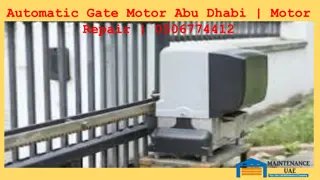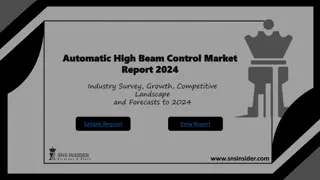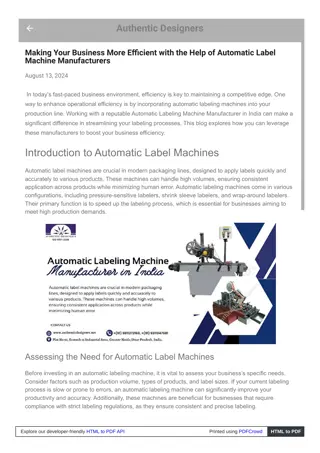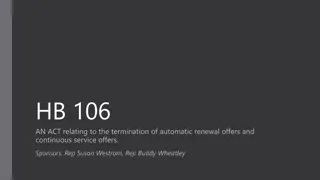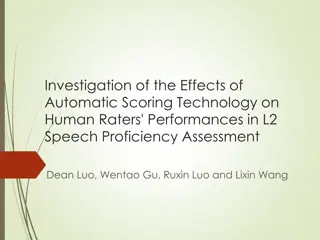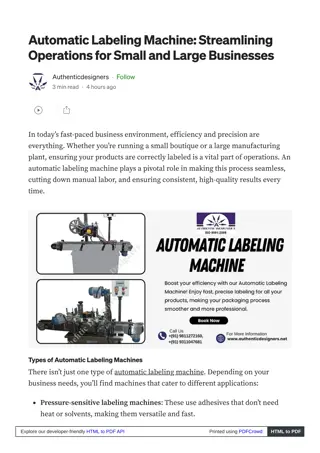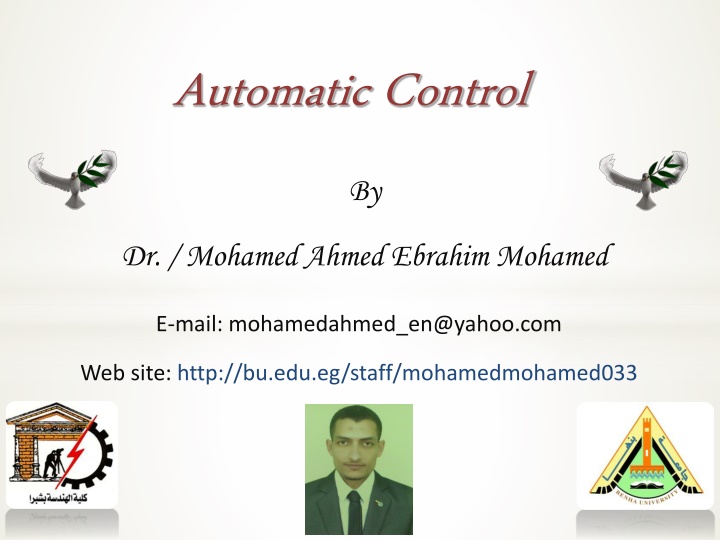
Automatic Control: Lectures, Bode Plots, Examples, and More
Dive into the world of automatic control with lectures, Bode plots, practical examples, and tips for more accurate amplitude plots. Explore topics such as Bode diagram analysis and phase angle calculations, with hands-on calculations and insights provided.
Download Presentation

Please find below an Image/Link to download the presentation.
The content on the website is provided AS IS for your information and personal use only. It may not be sold, licensed, or shared on other websites without obtaining consent from the author. If you encounter any issues during the download, it is possible that the publisher has removed the file from their server.
You are allowed to download the files provided on this website for personal or commercial use, subject to the condition that they are used lawfully. All files are the property of their respective owners.
The content on the website is provided AS IS for your information and personal use only. It may not be sold, licensed, or shared on other websites without obtaining consent from the author.
E N D
Presentation Transcript
Automatic Control raull5 raull5 By Dr. / Mohamed Ahmed Ebrahim Mohamed E-mail: mohamedahmed_en@yahoo.com Web site: http://bu.edu.eg/staff/mohamedmohamed033
raull5 raull5 Lecture (2
raull5 raull5 BODE PLOT
j + + + + 10(1 j ) Magnitude Bode plot of 0.1 j (1 ) 5 -- 20log10(1+j /0.1) -- -20log10(1+j /5) -- -20log10( ) -- 20log10( 10) -- 20log10|H(j )|
EXAMPLE R L s s + + ( ) 110 110 = = = = H s ( ) 1 2 110mH 10mF + + s s 1000 2 + + + + s R L s ( ) LC + vo vi + 11 s 110 10)( = = + + + + s s ( 100) j + + 0.11 = = H j ( ) ( ( j H j ) ) ) ( ( j ) ) + + 1 /10 1 /100 = = A 20log ( dB 10 = = + + j + + + + j j 20log 0.11 20log 20log 1 20log 1 10 10 10 10 10 100
Calculate 20log10|H(j)| at =50 rad/s and =1000 rad/s j 0.11( 50) 5)(1 ( 50) 0.11( 1000) (1 100)(1 ( 1000) H j 0 = = = = 0.9648 -15.25 ( 50) H j + + + + j j (1 0.5) = = = = H j 20log 20log (0.9648) j + + = = 0.311 dB 10 10 0 = = = = ( 1000) H j 0.1094 83.72 + + j j 10) = = 20log 20log (0.1094) 19.22 dB 10 10
Using the Bode diagram, calculate the amplitude of vo if vi(t)=5cos(500t+150)V. From the Bode diagram, the value of AdBat =500 rad/s is approximately -12.5 dB. Therefore, ( 12.5/20) 10 = = = = A 0.24 = = = = = = V AV V (0.24)(5) 1.2 mo mi
MORE ACCURATE AMPLITUDE PLOTS The straight-line plots for first-order poles and zeros can be made more accurate by correcting the amplitude values at the corner frequency, one half the corner frequency, and twice the corner frequency. The actual decibel values at these frequencies = = + + = = A j 20log 1 1 20log 2 3 dB dB 10 10 c = = + + = = A j 20log 1 1/ 2 20log 5 / 4 1 dB dB 10 10 c /2 = = + + = = A j 20log 1 2 20log 5 7dB dB 10 10 c 2 In these equations, + sign corresponds to a first-order zero, and sign is for a first-order pole.
STRAIGHT-LINE PHASE ANGLE PLOTS 1. The phase angle for constant Kois zero. 2. The phase angle for a first-order zero or pole at the origin is a constant 900. 3. For a first-order zero or pole not at the origin, For frequencies less than one tenth the corner frequency, the phase angle is assumed to be zero. For frequencies greater than 10 times the corner frequency, the phase angle is assumed to be 900. Between these frequencies the plot is a straight line that goes from 00to 900with a slope of 450/decade.
EXAMPLE + + j 0.11( /10)][1 0.11 /10) 1 ) j = = H j ( ) + + /100)] j [1 ( ( + + j ( ( ) ) = = 1 1 2 + + /100) j j 1 ( ( = = ( ) 1 1 2 0 = = 90 1 1 = = tan ( /10) 1 1 = = /100) tan ( 2
Compute the phase angle () at =50, 500, and 1000 rad/s. 0 0 = = ( 50) j = = ( 50) H j 0.96 15.25 15.25 0 0 = = ( 500) j = = ( 500) H j 0.22 77.54 77.54 0 0 = = ( 1000) j = = ( 1000) H j 0.11 83.72 83.72 Compute the steady-state output voltage if the source voltage is given by vi(t)=10cos(500t-250) V. = = = = = = V ( 500) H j V V (0.22)(10) 2.2 mo mi 0 0 0 = = + + = = = = ( ) 77.54 25 102.54 o i 0 = = v t t V ( ) 2.2cos(500 102.54 ) o
PHASE ANGLE PLOTS For a second-order zero or pole not at the origin, For frequencies less than one tenth the corner frequency, the phase angle is assumed to be zero. For frequencies greater than 10 times the corner frequency, the phase angle is assumed to be 1800. Between these frequencies the plot is a straight line that goes from 00to 1800with a slope of 900/decade. As in the case of the amplitude plot, is important in determining the exact shape of the phase angle plot. For small values of , the phase angle changes rapidly in the vicinity of the corner frequency.
=0.1 =0.3 =0.707
EXAMPLE 1 R + s + ( 4 2 25 + ) s L + LC + 50mH = = ( ) H s 1 R + 4 100 s s + 2 s s L LC vi + 1 vo + / 25 2 1 s 40mf = ( ) H s + ( 4 . 0 + 1 ( / 10 ) / 10 ) s s + + 1 / 25 j 1 10 / j = ( ) H 2 1 ( / 10 ) ( 4 . 0 j ) 1 = + j + 2 20 log 1 / 25 20 log 1 ( / 10 ) ( 4 . 0 j / 10 ) A 10 10 dB = ( ) 1 1
From the straight-line plot, this circuit acts as a low-pass filter. At the cutoff frequency, the amplitude of H(j ) is 3 dB less than the amplitude in the passband. From the plot, the cutoff frecuency is predicted approximately as 13 rad/s. To solve the actual cutoff frequency, follow the procedure as: 1 1 ( ) 2 4( ) 100 ( ) ( ) 4( ) 100 j j + + + + = = = = H H j c max + + j = = H j 2 2 2 + + (4 ) 100 1 c = = = = H j ( ) c 2 2 2 ) c 2 + + (100 (4 ) c = = 16 rad/s c
From the phase plot, the phase angle at the cutoff frequency is estimated to be -650. The exact phase angle at the cutoff frequency can be calculated as + + 4( 16 j + + 25) = = ( 16) H j 2 + + ( 16) j 4( 16) j 100 1 1 2 0 ( 16) j = = = = tan (16 / 25) tan (64 / (100 16 )) 125 Note the large error in the predicted error. In general, straight- line phase angle plots do not give satisfactory results in the frequency band where the phase angle is changing.
A sin t + t Input: ( ) Asin Output: A A/ is the normalized amplitude ratio (AR) is the phase angle, response angle (RA) AR and are functions of Assume G(s) known and let ( ) = = + s j G j K K j 1 2 = = + 2 2 2 G AR K K 1 K K = = arctan G 2 1
Ideal PID Controller. 1 = + + ( ) (1 ) G s K s c c D s I Series PID Controller. The simplest version of the series PID controller is = Chapter 14 + s 1 ( ) s ( ) I + G K s 1 c c D s I Series PID Controller with a Derivative Filter. The series controller with a derivative filter was described in Chapter 8 + + s s 1 1 1 + ( ) s I D = G K c c s s I D
Figure Bode plots of ideal parallel PID controller and series PID controller with derivative filter ( = 1). Chapter 14 Ideal parallel: 1 ( ) s = + + 2 1 4 G s c 10 s Series with Derivative Filter: + + 10 1 4 1 s s ( ) s = 2 G c + 10 0.4 1 s s
Advantages of FR Analysis for Controller Design: 1. Applicable to dynamic model of any order (including non-polynomials). 2. Designer can specify desired closed-loop response characteristics. 3. Information on stability and sensitivity/robustness is Chapter 14 provided. Disadvantage: The approach tends to be iterative and hence time- consuming -- interactive computer graphics desirable (MATLAB)
Mohamed Ahmed Ebrahim




